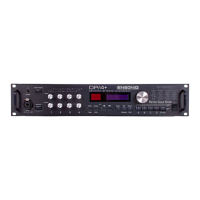Expander
Feedback
Feedback 1
Feedback
2
Filter
Hanger
Glossary
An
algorithm
that
increases the dynamic
range
of
a source
signal
by
making
loud
signals
louder
and
soft
signals softer. Expansion
can
be
used
to
lower
noise
on
poorly
recorded
tracks,
or
to
help
control leakage while recording. Signals
below
threshold
are
attenuated,
signals above
threshold
are
passed
with
a controllable fixed
gain
. This is
more
accurately
termed
downward
expansion.
A
signal
routing
in
which
some
of the
output
is
mixed
back
into
the
input.
Feedback
of
a
delay
line
is also called regeneration.
A
two-unit
signal
routing
option
in
the DP / 4 (see Section 3
of
the
Musician's
Manual
for
a signal-flow diagram). The A
and
B units
are
in
series;
the
output
of
the
B
unit
is
mixed
back
into
the
input
of
the
A
unit.
A feedback
amount
is available
among
the
config
parameters.
For example, if A
were
a delay
and
B
were
an
EQ,
the
feedback
path
would
cause
the
delay
to
regenerate
with
the EQ
in
the
regeneration
path
.
In
Feedback
1,
the
wet/
dry
mix
of
the
B
unit
combines the
dry
input
to A
with
the
output
of
B.
When
set
to
full
dry
(0)
only
the
dry
input
signal is heard.
A
two-unit
signal
routing
option
in
the DP / 4 (see Section 3
of
the
Musician's
Manual
for
a signal-flow diagram).
The
A
and
B units
are
in
series;
the
output
of
the
B
unit
is
mixed
back
into
the
input
of
the
A
unit.
A feedback
amount
is available
among
the
config
parameters.
In
Feedback 2,
the
wet/
dry
mix
of
the
B
unit
combines
the
output
of
A
with
the
output
of
B.
When
B is
set
to
full
dry
(0),
the
output
mix
of
A is
heard.
A device
that
attenuates
selected frequencies.
A
processor
that
originally
simulated
the effect
of
two
synchronized
tape
machines
in
playback
of
the
same
signal,
where
one
machine
was
manually
slowed.
The
small
delay
causes a
phasing
cancellation
that
produces
a
comb
filter
which
is
the
"flange"
effect.
In
the
DP
/ 4, flanging is achieved
using
interpolated
digital
delay
lines.
Gate (Noise Gate) A
device
that
completely attenuates a source signal
that
falls
below
a
pre-determined
threshold
. A
useful
tool
in
eliminating noise from recordings, as
well
as
controlling
effected signals.
Hysteresis
The
property
of
a
system
whose
event
threshold
is
determined
by
the
level, direction,
and
history
of
a controlling signal. Used
in
the
DP
/ 4 to
provide
greater
control
over
gating, triggering,
and
compression algorithms.
Input
Source The
signal
that
is fed into
the
DP / 4 via
an
unbalanced
cable.
It
is
the
signal
that
gets
processed
or
which
controls a
side-chain/key
.
Inverse Expander
An
algorithm
that
forces signals below a control
threshold
to
be
raised
to
that
threshold,
while
signals above
that
threshold are
passed
with
a controllable fixed
gain
.
This
helps
create a
more
even
recorded signal,
while
reducing
the
variability
in
the
noise
floor.
This
is
more
accurately
termed
upward
expansion.
Keyed Expander
An
expander
whose
effect is
determined
by
a control signal, as
opposed
to
the
input
signal. This control
signal
goes
through
an
EQ side-chain
when
the
EQed
control
signal
meets
the
requirements
for expansion,
the
expander
becomes active.
Often
used
to
improve
rhythm
guitar
or
drum
tracks.
ENSONIQ DP/4 Musician's Manual
XVII

